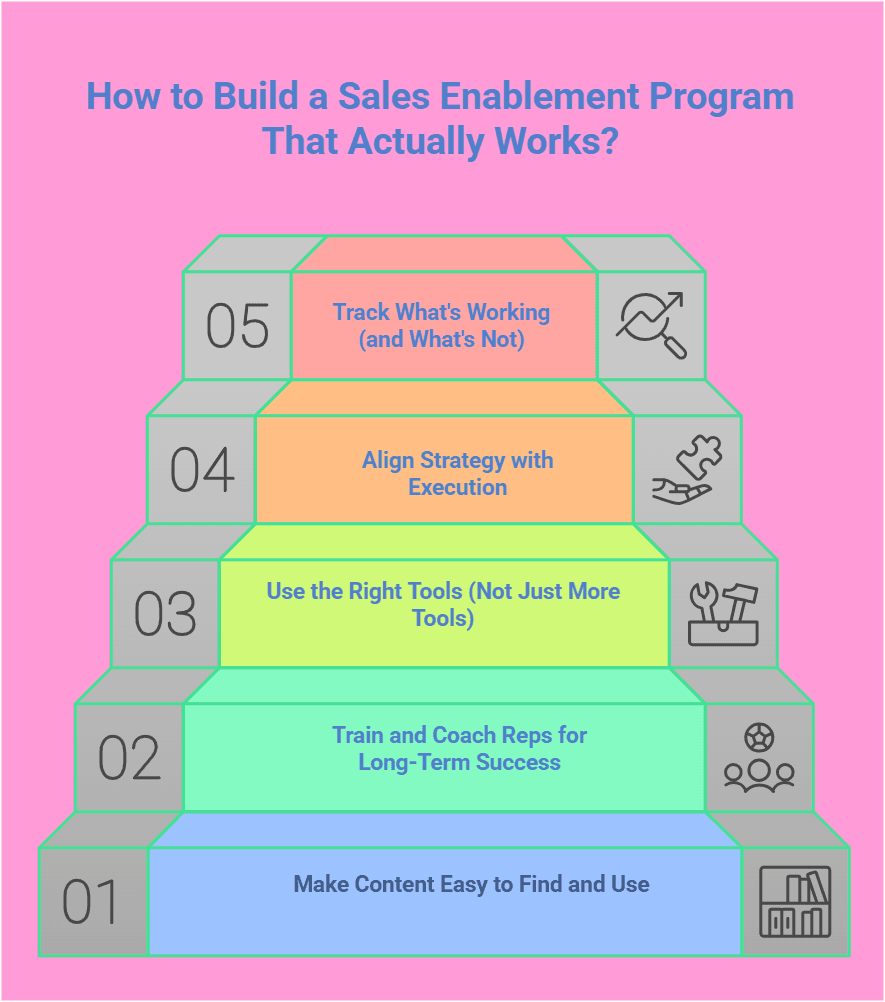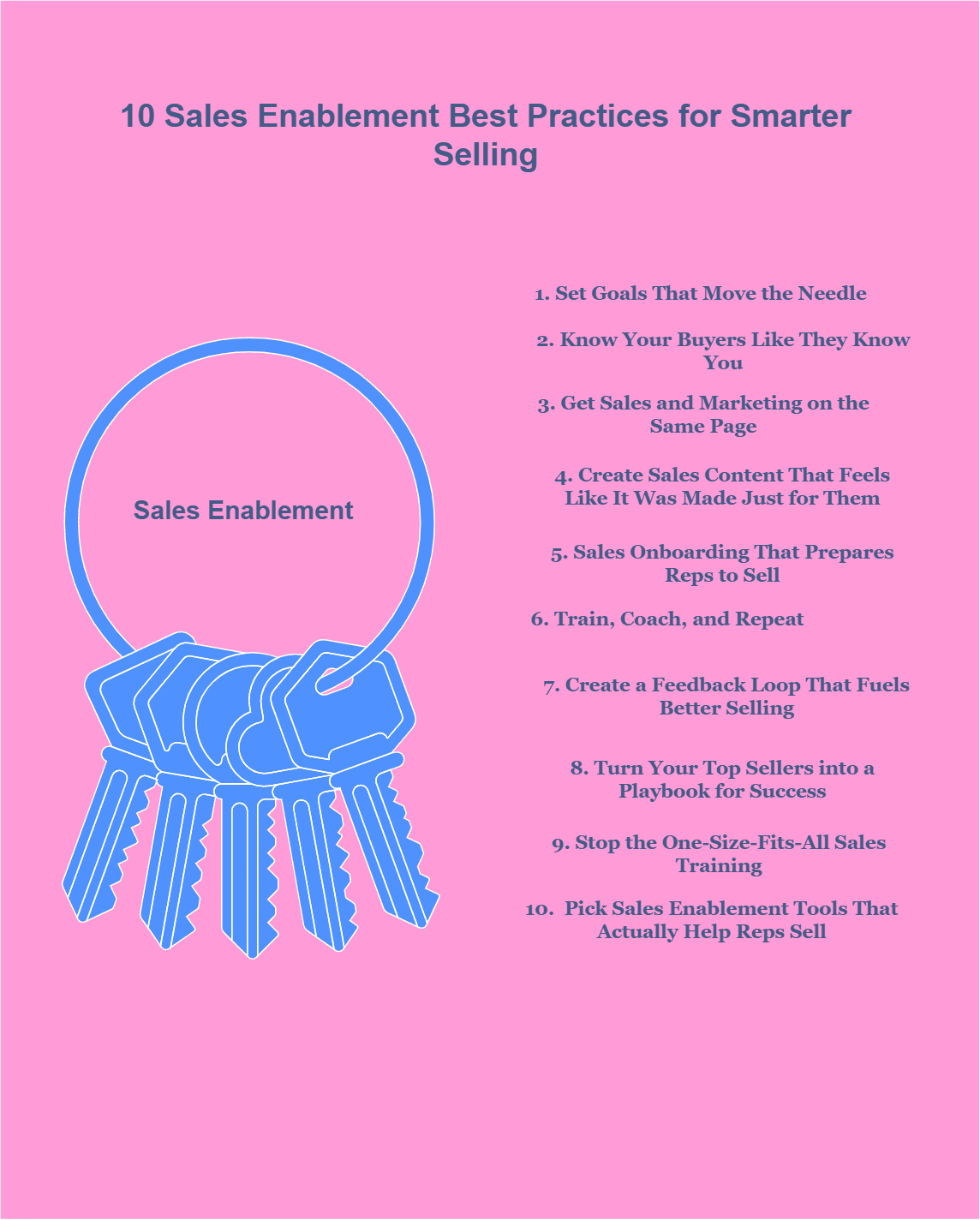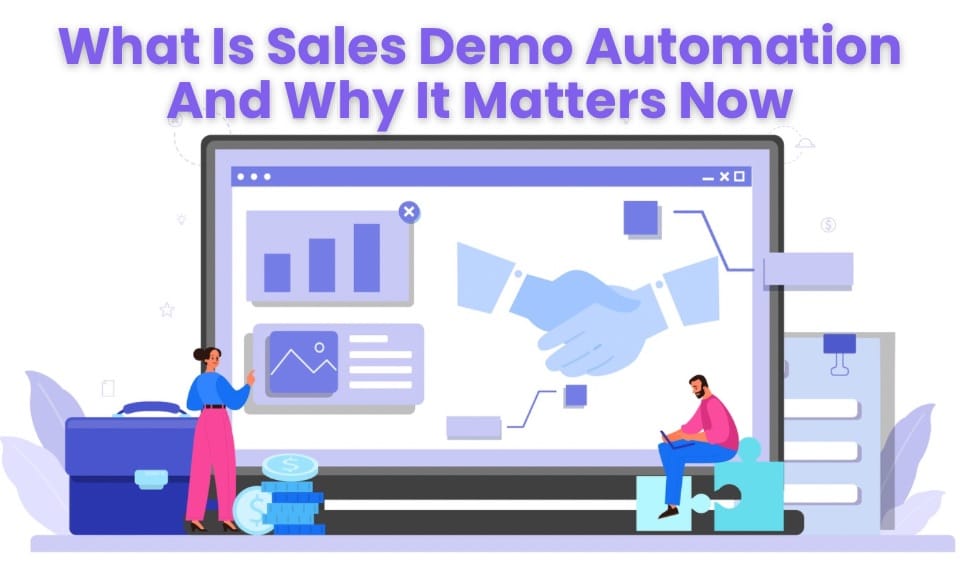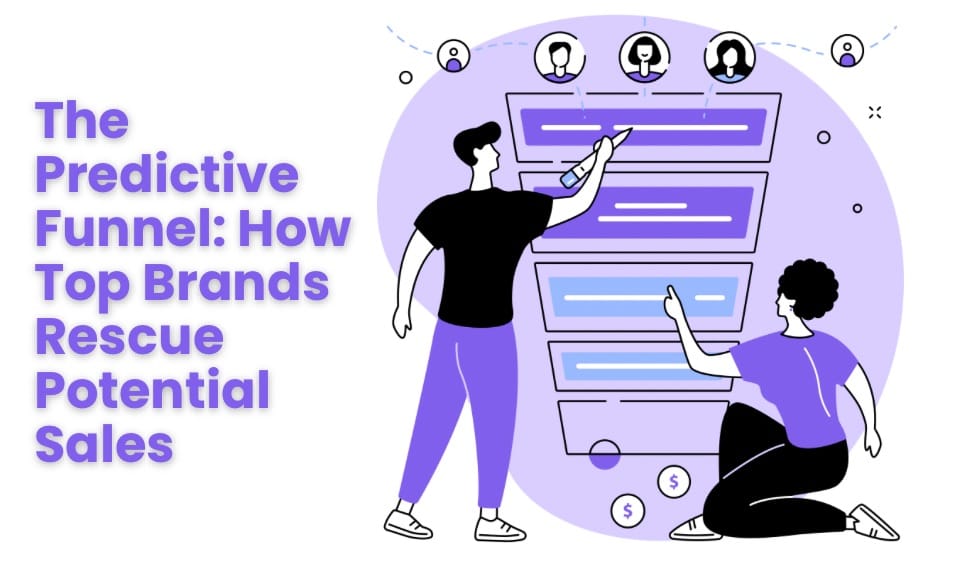Being an excellent sales rep, you've already nailed your pitch—the prospect seems interested… but then they suddenly disappear. Sound familiar? Maybe you're tired of hearing, "Let me check with my team."
The problem isn't always the product—it’s how well the sales team is equipped to handle objections, tailor messaging, and move deals forward.
Now, imagine your team has instant access to personalized pitch decks, real-time buyer behavior insights, and seamless playbooks that guide every sales call and conversation. With the right Sales Enablement strategies, the results can be game-changing.
When sales reps feel prepared, they sell with confidence. And when prospects sense that confidence, deals move faster. No more stalled conversations. No more second-guessing. Just smarter, more effective selling.
It’s time to equip your sales team with strategies that actually work. Let’s turn "I’ll think about it" into "Where do I sign?"
What Is Sales Enablement (and Why Your Team Needs It)?
Have you ever had a deal slip away because the prospect needed "more information" or wasn't convinced? It's frustrating—not because your product isn't great, but because your sales team didn't have the right tools at the right time to close the deal.
That's where effective sales enablement comes in. It's not just about training—it's about equipping reps with everything they need to sell smarter. Think of it like this:
Your team is about to pitch a CFO—do they have a financial impact case study ready?
A prospect asks about integrations—can your rep instantly pull up a technical FAQ?
A new sales hire is ramping up—are they learning from top performers or figuring things out independently?
Sales enablement solves these gaps by ensuring sales, marketing, and customer success work together. The result? Faster deals, better conversations, and more revenue.
How to Build a Sales Enablement Program That Actually Works?

Ever feel like your sales team is working hard but not closing enough deals? It's not always about effort—it's about having the right support system in place. That's where a strong sales enablement program comes in.
Before you start, take stock of what's working and what's not. Are reps struggling to find content? Is training inconsistent? Are deals stalling at the same stage? Identifying these gaps helps you build a program that actually moves the needle.
1. Make Content Easy to Find and Use
Your reps shouldn't be digging through folders for case studies mid-call. Sales enablement ensures content is organized, accessible, and tailored to different sales stages. Whether pitch decks, battle cards, or customer stories, reps need the right materials at the right moment.
2. Train and Coach Reps for Long-Term Success
A one-time training session won't cut it. To improve, sales teams need ongoing coaching, structured onboarding, and real-time feedback from experienced sales managers. Think of it like sports—even the best players practice daily. A strong enablement program promotes continuous learning by providing reps with constant learning opportunities through effective training programs, from sales kickoffs to role-playing tough objections.
3. Use the Right Tools (Not Just More Tools)
Adding software won't fix inefficiencies unless it helps reps sell smarter. Choose tools that:
Integrate with your CRM for seamless data tracking.
Automate workflows to eliminate repetitive tasks.
Provide insights into buyer behavior and deal progress.
Sales enablement tech should simplify, not complicate. If your reps spend more time logging data than selling, it's time to rethink your stack.
4. Align Strategy with Execution
Sales enablement isn't just about efficiency—it's about helping your sales operations team win more deals, including optimizing the sales cycle length. That means:
Reducing ramp time for new hires.
Creating a repeatable process that top performers use.
Improving forecasting accuracy so leadership can plan.
A well-executed program turns sales enablement from a support function into a revenue driver.
5. Track What's Working (and What's Not)
If you're not measuring impact, you're guessing. Track key metrics like:
Content engagement – Are reps using the materials provided?
Sales cycle efficiency – Where do deals stall?
Rep performance – Are trained reps closing more deals?
Sales enablement isn't a set-it-and-forget-it initiative. Constant analysis ensures your team is constantly adapting and improving.
10 Sales Enablement Best Practices for Smarter Selling

Hard work alone doesn't close deals—the right sales enablement strategy does. At the end of the day, the most successful sales teams don't just rely on talent; they follow structured enablement practices that keep them aligned, efficient, and consistently winning.
While these best practices are commonly seen in SaaS startups, they apply to any business looking to streamline their sales process, improve conversions, and drive predictable revenue. Here are 10 proven tactics that help teams sell smarter, not harder.
1. Set Goals That Move the Needle
Sales enablement without clear goals is like giving your reps a GPS with no destination. To make a real impact, start by figuring out what needs fixing.
Be ready to ask the tough questions:
Are deals stalling? Is the team struggling with slow follow-ups, long sales cycles, or low close rates?
Where's the time going? Are reps spending more time hunting for content than actually selling?
Is marketing really helping? Or are sales reps left tweaking pitch decks themselves?
What does success look like? More closed deals? Higher contract values? Better retention?
Once you've identified the biggest pain points, set specific, measurable goals. Whether shortening the sales cycle, increasing quota attainment, or fixing content gaps, every initiative should directly support revenue growth.
2. Know Your Buyers Like They Know You
Your prospects aren't just casually browsing—they're researching, comparing, and making decisions long before they talk to a rep. If you don't understand them, you can't sell to them.
Start by breaking your customers into clear buyer personas based on real data, not assumptions.
Ask the right questions:
What's their role? What challenges do they face daily?
What are their goals? Are they trying to cut costs, boost efficiency, or scale faster?
How do they research? Do they rely on industry reports, peer recommendations, or online reviews?
What objections do they have? Is price the issue, or do they need social proof?
How do they prefer to communicate? Some want quick emails, others need a call.
Talk to marketing, sales, and customer success teams for real insights. Use this data to personalize outreach, refine messaging, and tailor demos—because a one-size-fits-all pitch won't cut it. The more relevant your approach, the faster you'll close.
3. Break the Silos—Get Sales and Marketing on the Same Page
Ever seen sales reps ignore marketing content because "it doesn't help them close deals"? Or are marketers frustrated that sales aren't using their hard work? That's what happens when teams don't collaborate.
Imagine this: Marketing creates a killer case study, but sales don't know it exists. Meanwhile, reps struggle to prove ROI to prospects. The result? Missed opportunities and a disconnected buyer experience.
Here's how to fix it:
Regular feedback loops – Sales should tell marketing what content helps them close deals, and marketing should adjust accordingly.
Shared data and insights—If sales knows why deals are won or lost, marketing can refine messaging to address objections earlier.
Joint strategy sessions: Both teams should collaborate on content, campaigns, and messaging to ensure a seamless customer journey.
When sales and marketing collaborate, every touchpoint feels intentional, prospects move through the funnel faster, and closing deals becomes easier.
4. Create Sales Content That Feels Like It Was Made Just for Them
Generic sales content gets ignored. If prospects don't see themselves in your messaging, they won't engage with potential customers. The best sales enablement teams don't just create content—they create the right content for the right buyer. It addresses buyer needs during the buying process at the right time, effectively addressing the customer’s journey.
Think about it: A VP of Sales and a CTO might influence the buying decision, but they care about different things. One wants revenue impact, the other needs tech compatibility. If your sales content doesn't address their concerns, you'll lose their interest before selling.
Here's how to make sales content actually work:
Know your audience – Use buyer personas to understand goals, challenges, and objections.
Make it relevant – Create sales decks, case studies, and one-pagers that speak directly to each persona.
Use the right format – Some prospects want detailed whitepapers; others prefer quick-hit comparison charts.
By aligning content with the buyer's journey, pain points, and preferred communication style, your sales team won't just send materials—they'll send something the prospect actually wants to read.
5. Sales Onboarding That Prepares Reps to Sell
Throwing new sales hires into the deep end and hoping they figure it out? That's a recipe for lost deals and slow ramp times. Without a structured onboarding process, reps waste time guessing instead of selling.
Picture this: A new rep joins, but they're unclear about who they're selling to, how to position the product, or what content to use. The result? Missed quotas, long ramp-up times, and frustrated sales leaders.
Here's how to get new hires selling faster:
Give them a roadmap – Clear milestones for learning products, personas, and processes.
Make training hands-on – Real call shadowing, objection-handling practice, and mock pitches.
Provide sales enablement content – Playbooks, case studies, and messaging guides at their fingertips.
Schedule regular check-ins – Catch issues early and reinforce learning.
A strong onboarding process isn't about information overload—it's about giving reps the confidence to start closing deals as soon as possible.
6. Train, Coach, and Repeat—Because One Session Won't Cut It
One-time sales training won't turn reps into closers. Without continuous sales coaching, even the best techniques fade fast. To build a winning sales team, training needs to be consistent, hands-on, and tailored to the real challenges reps face every day.
Here's what makes training stick:
Role-playing real sales scenarios – Objection handling, discovery calls, and closing techniques should feel second nature.
Learning from top performers – High-achieving reps should share their strategies so best practices become standard.
Bite-sized, ongoing education: Micro-learning, playbooks, and quick-hit training sessions keep reps sharp without distracting them from selling.
Excellent sales training isn't about dumping information but reinforcing the proper habits until success becomes automatic. When reps practice as they sell, they sell as they practice.
7. Create a Feedback Loop That Fuels Better Selling
Sales teams hear it all—why deals close and stall and what customers think about your product. But if that feedback isn't captured and acted on, you're missing a huge opportunity to improve sales and the user experience.
Here's how to build an actual feedback loop:
Get customer insights firsthand – Reps should regularly collect feedback from prospects and buyers about what worked, what didn't, and what's missing.
Share with marketing and product teams – If customers keep asking for a specific feature, that's gold for your product roadmap.
Close the loop – Let customers know their feedback matters by showing them real improvements based on their input.
The best sales enablement isn't just about selling—it's about listening, refining, and continuously improving the buyer experience. When customers feel heard, loyalty (and revenue) follow.
8. Turn Your Top Sellers into a Playbook for Success
Every sales team has a few salespeople who consistently crush their targets. But what if their success wasn't just individual talent but something repeatable?
Imagine one rep closing deals 30% faster while another struggles with the same objections. The difference? Tactics, messaging, and approach. Instead of keeping that knowledge locked away, turn top-performing reps into your best training resource.
Here's how to do it:
Analyze sales data – Identify patterns in deal velocity, win rates, and customer engagement.
Spot what works – Are top reps asking different questions? Using content more effectively? Closing faster?
Make it teachable – Have high performers lead coaching sessions, role-plays, or breakdowns of successful deals.
When sales enablement leverages real success stories, the entire team levels up—and winning becomes the standard, not the exception.
9. Stop the One-Size-Fits-All Sales Training
Not every rep struggles with the same challenges, so why train them like they do? Some need help with prospecting, others with closing, and others with better objection handling. Generic training wastes time and fails to move the needle.
Here's how to make sales training actually effective:
Assess individual strengths and gaps – Use call recordings, performance data, and manager insights to pinpoint where each rep needs support.
Personalized coaching plans – Instead of broad workshops, tailor sessions to focus on specific skill-building.
On-demand learning: Let reps access micro-training when they need it, not just when the next team session happens.
When training is customized and practical, reps improve faster—and those improvements translate directly into more closed deals.
10. Pick Sales Enablement Tools That Actually Help Reps Sell
Leveraging the right tools is more than important. A cluttered tech stack slows reps down, but a well-integrated enablement platform makes selling easier, faster, and more effective.
Here's what to look for in a sales enablement tool:
Easy content access – Reps shouldn't waste time hunting for pitch decks or case studies.
Seamless CRM integration – It adds extra work if it doesn't sync with your CRM.
Automation that works for you – Less admin means more selling. The right tool streamlines workflows, not complicates them.
Wonderful Demo Software – A tool that has everything sorted and ready to showcase your demo is worth adding!
Instead of chasing the latest software trend, focus on tools that solve real sales bottlenecks. When tech removes friction, reps spend less time managing processes—and more time closing deals.
Make Every Demo Count with Interactive Demo Software – SmartCue
Did you know a great demo can not only capture your target audience’s attention but also make your sales reps’ jobs easier? Think about it—when reps have all the essential information packed into a compelling demo, they can confidently showcase it to potential clients, making the sales process smoother and more effective.
However, keep in mind that a long, generic product demo can lose a prospect's interest fast. Buyers want to see precisely how your solution solves their problem—quickly and clearly. That's where interactive demo software like SmartCue changes the game.
Instead of essential screen recordings, SmartCue lets sales teams create custom, interactive demos that guide prospects through real product experiences. Features like:
Tailored demo paths that showcase only the most relevant features.
Screen recording and editing to highlight key workflows.
Behavior tracking to see where prospects engage (or drop off).
Companies across industries—EdTech, HR, Cybersecurity, Healthcare, and more—use SmartCue to create sales demos that convert. Take NexLvL, an AI-powered CRM. Their interactive SmartCue demos give prospects a hands-on experience, making it easier to see how automation can transform their business. These guided experiences allow businesses to explore the platform's capabilities, from automated workflows to chatbot integrations.
Want to see it in action? Watch the demo here.
Sales Enablement: Give Your Sales Team What They Need to Win
Sales enablement isn't just another buzzword—it differentiates between a deal closing and a prospect disappearing. When your reps have the right tools, content, and training, selling stops feeling like a grind and starts feeling like a win.
But here's the thing—it's not just about having resources; it's about using them the right way. A solid sales enablement strategy means personalized content that speaks to buyers, seamless onboarding that gets new reps up to speed quickly, and training that actually sticks.
Sales are evolving, and so is the way buyers make decisions. The teams that master sales enablement don't just support their reps—they create unstoppable momentum. Give your team the right tools, and watch them turn hesitation into closed deals.
Frequently Asked Questions
What tools are vital for a successful sales enablement program?
Key tools for a successful sales enablement program include CRM Systems for centralized customer data, Sales content management through Content Management Systems for organized content distribution, Communication and Collaboration Tools for efficient team interaction, and various sales enablement software that integrate these functions for a streamlined content creation process and sales performance operation.
How do sales enablement strategies benefit companies?
Sales enablement strategies enhance sales productivity by arming sales representatives with optimal skills, knowledge, and resources. They bridge gaps between sales and marketing teams, aiding uniform sales strategies that bolster revenue growth and improve sales metrics related to the sales pipeline. These sales enablement strategies offer valuable support to tackle the competitive market and improve overall customer experience, empowering sales enablement leaders to lead effectively.
How does cross-department collaboration impact sales enablement?
Cross-department collaboration fosters efficient communication among sales and other departments, such as marketing and product development. This ensures a unified approach to achieving shared objectives, identifying customer journey discrepancies, and implementing tailored content strategies. Overall, it contributes to successfully streamlining sales enablement and improving sales results.
What are the core components of sales enablement?
Sales enablement involves connecting sellers with relevant content, training for repeatable wins, and measuring practices against the buyer’s journey and bottom-line results as part of the sales enablement manager role and sales enablement process. Key components include providing diverse, advanced training, curating engaging content, leveraging suitable technology tools, fostering collaborative work environments, and aligning sales goals with overarching business objectives.


